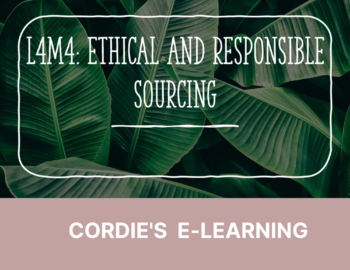L4M4 e-Learning
$32.91
Description
1.0 Understand options for sourcing requirements from suppliers
1.1 Identify the sourcing process in relation to procurement
- Definitions of sourcing and outsourcing
- Make or buy decisions
- Strategic and tactical sourcing costs and benefits of outsourcing
- Outsourcing non-core and core work or services
- Supplier pre-qualification or criteria for supplier appraisal
- Vendor or supplier performance management
- Risks in outsourcing
- The market development and growth of outsourcing
- Regulations affecting employees terms of employment
1.2 Differentiate between approaches to the sourcing of requirements from suppliers
- Single, dual and multiple sourcing arrangements
- The use of tendering: open, restricted and negotiated approaches to tendering
- Direct negotiations with suppliers
- Intra company trading and transfer pricing arrangement
- Implications of international sourcing
1.3 Define selection criteria that can be commonly applied when sourcing requirements from external suppliers
- Typical selection criteria such as; quality assurance, environmental and sustainability, technical capabilities, systems capabilities, labour standards, financial capabilities and credit rating agencies
- The importance of supplier financial stability and due diligence checks
- Ratio analysis to make conclusions on profitability, liquidity, gearing and investment
- The limitations of ratio analysis
1.4 Define award criteria that can be commonly applied when sourcing requirements from external suppliers
- Typical award criteria such as; price, total life cycle costs, technical merit, added value solutions, systems and resources
- Balancing commercial and technical award criteria
2.0 Understand the key processes that can be applied to the analysis of potential external suppliers
2.1 Analyse commonly used sources of information on market data that can impact on the sourcing of requirements from external suppliers
- Compiling data on expenditures on suppliers
- Indices that measure economic data
- Secondary data on markets and suppliers
- Commodity pricing
- Analysing potential sales
- Financial reports and supplier financial stability
- The role of credit rating agencies
2.2 Identify the key processes used for obtaining quotations and tenders
- Advertising requirements
- Requests for information or quotations
- The operation of tendering
- Formalised arrangements for tendering
- Decision criteria for dispensing with tendering
2.3 Identify the criteria that can be commonly applied tothe assessment of quotations or tenders
- Assessment of suppliers proposals
- The use of weighted points systems for assessment
- Recommending sources of supply
- Financial statements such as the profit and loss, balance sheet and cash flow statements
- Measures and ratios of profitability, liquidity, gearing and investment
- The limitations of ratio analysis
- Added value
2.4 Analyse how electronic systems can be used to help the sourcing of requirements from external suppliers
- E-requisitioning and purchase ordering systems
- E-catalogues on intranets and the internet
- The use of e-auctions and reverse auctions
- E-tendering systems
3.0 Understand compliance issues when sourcing from suppliers
3.1 Compare the key legislative, regulatory andorganisational requirements when sourcing in the not for-profit, private and public sectors
- The use of competitive tendering processes
- The impact of timescales on tendering processes
- Procedures for contract award
- Regulatory bodies that impact on the private sector
- Regulations that impact on product and safety standards
3.2 Compare the key legislative, regulatory andorganisational requirements when sourcing frominternational suppliers
- Documentation relating to imports
- Import duties and tariffs
- Payment mechanisms
- The use of INCOTERMS
- Customs control and clearance
- Currency regulations
- Applicable law
4.0 Understand ethical and responsible sourcing
4.1 Describe the impact of international ethical standardson procurement and supply
- Bribery
- Corruption
- Fraud
- Human rights
- Modern slavery
4.2 Identify practices that support ethical procurement
- Application of the CIPS Code of Conduct
- Ethical codes of practice
- Prequalification and assessment criteria
- Due diligence on suppliers and risk assessment
- Supporting information on ethical practices insupplier quotations and tenders
- Contractual clauses
- Supplier monitoring
- KPIs
4.3 Compare the use of audits and other feedbackmechanisms to evaluate ethical standards in theworkplace
- Monitor supplier performance
- Encourage dialogue with suppliers on improvements to process
- Recommend remedial actions where appropriate
- Identify and address potential conflicts of interest
4.4 Contrast processes and practices that the organisation could adopt to meet the requirements of Corporate Social Responsibility (CSR)
- The triple bottom line – profit, people and planet
- Adopt sustainable practices, standards and specifications in the supply chain
- Consider the social impact of the organisation’s behaviours
- Design procurement processes to deliver social outcomes as well as, or as an alternative to, normal economic measures of value
- Expand reporting frameworks to include ecological and social performance
- Define organisational value for money to include social outcomes – use of local labour, participation of disadvantaged groups




